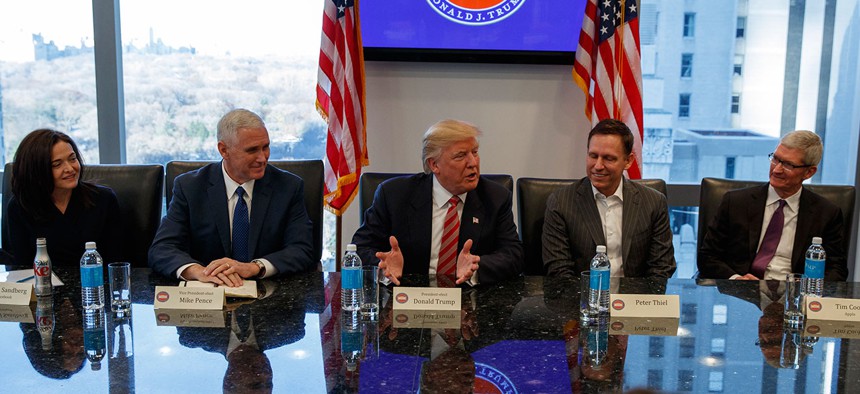
President-elect Donald Trump speaks during a meeting with technology industry leaders at Trump Tower in December. Evan Vucci/AP
With Gritted Teeth, Tech Royalty Has Returned To The White House. Here’s The Agenda.
Who's ready for "Government-as-a-Service"?
President Donald Trump is keen to get cozy with Silicon Valley’s executives. The executives? Not so much. That’s in large part due to tech workers’ anger toward a president who has attacked US immigrants (often their colleagues), vowed to gut visa programs such as the H1-B (which are frequently used to employ foreign engineering talent in the US), reneged on US promises in the Paris Agreement to slow climate change (a priority issue to many in California), among other things.
Uber’s Travis Kalanick and Tesla’s Elon Musk have already left a presidential advisory council over the rift. But it’s not enough to keep away about two dozen executives from today’s White House meeting.
On June 19 and June 22, C-suite executives will gather under the aegis of a new White House division, the Office of American Innovation, which is led by Trump’s son-in-law, Jared Kushner (a target in the Russian election meddling investigation) and charged with “implementing policies and scaling proven private-sector models to spur job creation and innovation.”
CEOs at Apple, Amazon, Microsoft, Palantir, IBM, Intel, Oracle, and about a dozen other tech companies will attend, reports Axios. They’re due to meet with White House leadership including Trump, vice president Mike Pence, first daughter Ivanka Trump, and several cabinet heads.
In opening remarks, Kushner told the group that initial efforts to modernize the government’s technology infrastructure were “working and it’s very exciting,” according to press pool reports. Rather than finding a bureaucracy resistant to change, he said, “so far I have found exactly the opposite.”
Quartz has obtained the draft meeting agenda (embedded below) from one of the companies participating. The document frames the effort as “government-as-a-service.” It calls for 10 working groups to propose changes to major aspects of government IT and technology. Participants will “collaboratively develop ideas for how government can operate like a modern technology enterprise” on issues ranging from cybersecurity and procurement to cloud strategy and better user-interfaces for public services. During each session, executives will propose solutions and identify areas where their companies can add to the effort.
If it feels familiar, that’s because we’ve been here once before. Last December, tech executives gathered at the behest of the president, ostensibly to discuss policy, over a roundtable of technology’s most powerful CEOs. At the time, it was seen as a power play showcasing Trump’s new executive authority, given the opposition to the new president back on the executives’ tech campuses. Now that the White House seems to be pursuing constructive action to transform government IT, this meeting might be different.






